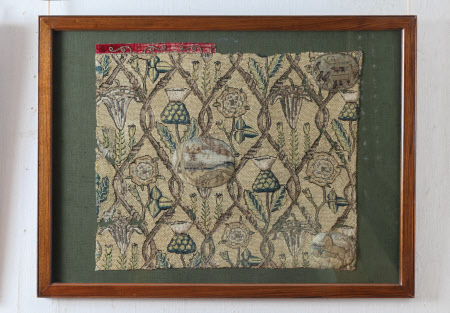The Fox and the Eagle's Young
Mary, Queen of Scots (1542–1587)
Category
Textiles
Date
1569 - 1587
Materials
Linen canvas, Silk thread, Metal thread, Velvet, Walnut, Glass
Measurements
490 mm (H)570 mm (W)620 mm (H)820 mm (W)
Order this imageCollection
Hardwick Hall, Derbyshire
NT 1129525
Summary
Fragment of a furnishing textile, probably from the valance of a bed or wall-hanging, entitled 'The Fox and the Eagle's Young' designed and embroidered by Mary Queen of Scots (1542 - 1587) and mounted in a glazed walnut frame. The linen-canvas ground has a thread count of 32 x 28 per square inch and is worked in thick silk floss and silver and gold filé in two-stage cross stitch and trammed tent stitch, while the smaller applied roundels are cut from a finer linen-canvas with a tread count of 37 x 30 per square inch. The panel is decorated with a repeating pattern of emblematic flowers, the Lily of France, the Thistle of Scotland and the Rose of England arranged in a diamond shaped lattice of intertwined ropes. It is embellished with three applied oval panels, the largest featuring a scene of a Fox and an Eagle with its young falling from their nest, the two smaller ovals illustrating mice and a prancing mule. The scenes in the ovals are based on illustrations to Gabriel Faerno's Centum Fabulae ex antiques auctoribus (Antwerp, 1573). The upper edge is finished with a partial band of red velvet decorated with a series of scroll motifs in couched gold twist. One of a pair of fragments, see 1129524 (HHE/T/159).
Full description
Mary I of Scotland (1542- 1587), later known as Mary Queen of Scots, was an accomplished embroiderer throughout her life. Needlework was considered an essential skill for a woman of Mary’s status. She acquired her skills as part of her education at the 16th century French Royal Court under the supervision of her future mother-in-law Catherine de ’Medici (1519-1589), having been sent there as a young child to be brought up in preparation for her role as the wife and eventual Queen of François II (1544 – 1560), King of France. The Hardwick Hall collection contains two fragments of needlework by Mary, The Fox and the Ravens Young and Two Frogs on a wellhead (NT 1129524), believed to be part of a wall hanging or bed valance. They are likely to date from between 1569 and 1584, the period when Mary was in the custody of George Talbot, 6th Earl of Shrewsbury (1528-90) at Sheffield Castle and Manor. This followed her dramatic flight from Scotland to England in July 1568, a catholic queen deposed by a rebellion of protestant Scottish lords. She sought refuge with her cousin, Elizabeth I (1533-1603) but was instead perceived as a significant political and religious threat and taken into protective custody. In the years of her captivity, Mary used the activity of sewing as a way to productively fill her time, embroidering cushions, bed hangings and items of dress. At times needlework may have been her way of coping with the emotional stress of her exile and incarceration. In 1569, in the early days of her captivity, Elizabeth’s envoy Nicholas White visited Mary and reported: I asked her Grace since weather did cut off all exercise abroad how she passed the time within; she said that all the day she wrought with her needle and that the diversity of the colours made the work seem less tedious, she continued so long at it till the very pain did make her give over and with that laid her hand upon her left side and complained of an old grief newly increased there. Mary made sophisticated use of emblems and mottos to assert her identity and express defiance of her cousin and captor, Elizabeth I. Both embroideries have a repeating pattern of emblematic flowers, the Lily of France, the Thistle of Scotland and the Rose of England arranged in a diamond shaped lattice of intertwined ropes, symbolically linking the French and Scottish crowns with that of England, to which Mary had, when a young queen of France, laid claim. In an atmosphere of continuous political intrigue, this combination of emblems might have been interpreted as treasonous. The needlework fragments are further embellished with needlepoint scenes of small ovals illustrate designs taken from Gabriel Faerno’s Fabulae Centum published in 1560. In the central oval, The Fox and the Ravens Young illustrates a story of greed and betrayal of friendship though two animals that had previously lived as neighbours. The Raven steels a fox cub to feed its young and refuses to return it and so the Fox sets fire to the Raven's nest, eating the scorched fledglings as they fall (Levey, 2007). In Two Frogs on a wellhead, the central panel of frogs includes Mary’s crowned monogram for Maria Regina, stitched in yellow.
Makers and roles
Mary, Queen of Scots (1542–1587), designer Mary, Queen of Scots (1542–1587), creator
References
Levey 2007: Levey, Santina. M., The Embroideries of Hardwick Hall: A Catalogue. London: National Trust; 2007., pp. 333-4 Slocombe 2016: Slocombe, Emma., ‘The Embroidery and Needlework of Bess of Hardwick’ in Adshead, David., Taylor, David.A.H.B., (eds.), Hardwick Hall : A Great Old Castle of Romance. New Haven: Yale University Press (2016), 110-132., pp. 118-9 Swain, 1973: Margaret Swain. The needlework of Mary Queen of Scots. New York; London: Van Nostrand-Reinhold, 1973.
